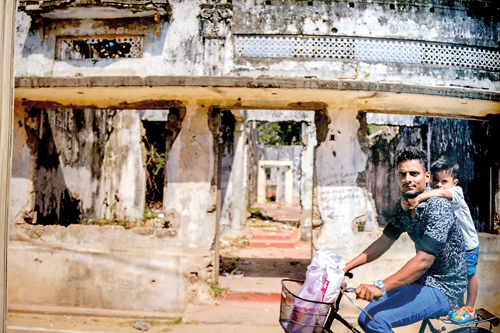Speak to us, not about us

A photograph from the book
Sarah Kabir trips nimbly down her unpolished wooden staircase to meet us. Looking up I see a petite young woman with elfin looks who gives off an air of mature calmness and assurance.
It is easy to see her brave the hinterlands of the Vanni, and to see the victims of the war opening up to her, abandoning any vestiges of wariness or self-consciousness: a process of catharsis for them, and for Sarah valuable material from which she would bring out her book, Voices of Peace.
Over two years’ research brought to life this landmark volume published last month. It combines the stories of ten former LTTE cadres and ten Sri Lankan military personnel who actively fought on the front lines. It is different from previous publications aiming at post-war reconciliation, employing a unique format of simple storytelling, attempting to blur the lines of division.
“You just need to listen” is the invitation of the book, and once you tumble into its pages, you are gripped by the stories of war and peace by individuals, scarred individuals emerging from conflict to peace; individuals filled with sunny hope for the future.
Sarah grew up in Colombo. War did not infringe closer than background rumblings and smoke in the horizon, but from teen years she grew more inquisitive about the ground reality in the North. Politics ran in the family, but for Sarah her privileged background essentially entailed giving back. She volunteered in Sarvodaya orphanages, before she left to Bristol University to study social policy. Later she would do her Master’s at the London School of Economics in International Development and Humanitarian Emergencies.
More than the training at these prestigious institutions, however, her book owes to the chance that threw her into the midst of a team of anthropologists in between the two degrees. This brush with “the most human of the sciences” fascinated her. The anthropologists immerse themselves in the environment they study and become part of the community they research.
“It taught me that if you are trying to really talk to people and find out things- you shouldn’t be going into some community and extracting stories from them and coming out- because you are taking from them and not giving back; it doesn’t help them in any way. I learned to become a part of the community- that is why in this research I spent a lot of time getting to know them.”
In Cambodia, while working on her Master’s, Sarah would also discover the importance of storytelling as a methodology. Then she would stumble on a quote, by a Tunisian activist called Aya Chebbi. “Speak to us; not about us” and “we have our own voices. You just need to listen.”
At this point her mind was tugged at by the reconciliation process going on back home.

Sarah Kabir
“I realized there was a gap between understanding and listening to the voices of those who actually fought during the war. There were collections of testimonials from victims and widows- but that was not enough.”
Those who actually fought during the war, though empowered during the conflict, were now neglected. “I wanted to provide them this space, to give them ownership of the peace process.”
As she chatted with her subjects from both sides she would feel the boundaries separating the two camps dissolve. They had commonalities and also within their own groups were so many divisions- to do with class or caste or creed. Within the military itself were intra-group divisions. However the main similarity between them became more and more opaque: they were all human.
Sarah would learn about the sacrifices they made, what they gave up- but she would be energized by the hope they had for the future. She wants similar hope to be sparked in the readers. “If each of us can embrace this moment of peace instead of being critical and cynical about it, we can achieve a lot more.”
The stories that unravel in the book remain sincerely the tellers’. Their voices are respected. Sarah tell us no changes were done even when the things they said seemed factually inaccurate. “Because these are their stories, and there’s a reason why they are saying something”.
The message embedded in the heart of the stories is that they want to move ahead with peace. “And that we need to identify all of us as Sri Lankans and live in harmony instead of building rifts based on political parties or caste or religion or ethnicity.”
Sarah hopes the book will open up people’s minds and create a a more conducive environment for the post-war reconciliation process. “Because as people open up their minds they will understand more, learn more, and they will be more inviting towards a peaceful process brought on by policy makers.”
The book is also a valuable research tool for those interested in post-war reconciliation. There are many suggestions from storytellers on what more can be done.
For instance, they point out the importance of the younger generation being aware of the stories of the war, and what was sacrificed, so that they don’t take back arms. A key insight is on the importance of interaction. The storytellers narrate how interaction helped them break down fear and hatred and other differences. The book teaches that for a better, peaceful society, it is important for everyone to engage socially with those whom you consider ‘the other’.
The book would not have had its compelling allure if not for the eloquent pictures by Munira Mutaher. They celebrate the recommencing of disrupted life, hope, and a new dawn over the ashes of a dark night.
Munira stood by Sarah, camera in hand, throughout the project, putting her heart and soul into it. “At the launch someone said that the nice pictures would be at odds with the harsh stories- but they are really not there as an aesthetic tool or to make the book pretty.”
The pictures are part of storytelling as a methodology, taken during fieldwork, and showcase the storytellers and their daily lives, what their situation is like now, and the changes they have made. The stories themselves are told lucidly in simple language.
Historical Dialogue under GIZ has come to support Sinhala and Tamil translations of the book, which Sarah believes would be of more importance than the English version, as it would reach out more within the country.
The end pages of the book are a panorama of silhouetted palmyras over which the dawn sun rises. It is a book saturated with so much hope, and it marks a beginning.
As Sarah says, “These were the people who were there during the war. These are the people we need to help first if we want to strengthen peace in Sri Lanka.”
Voices of Peace is available at all leading bookshops.


